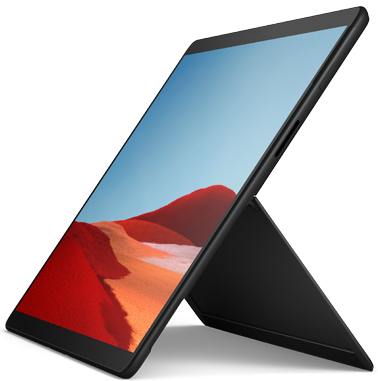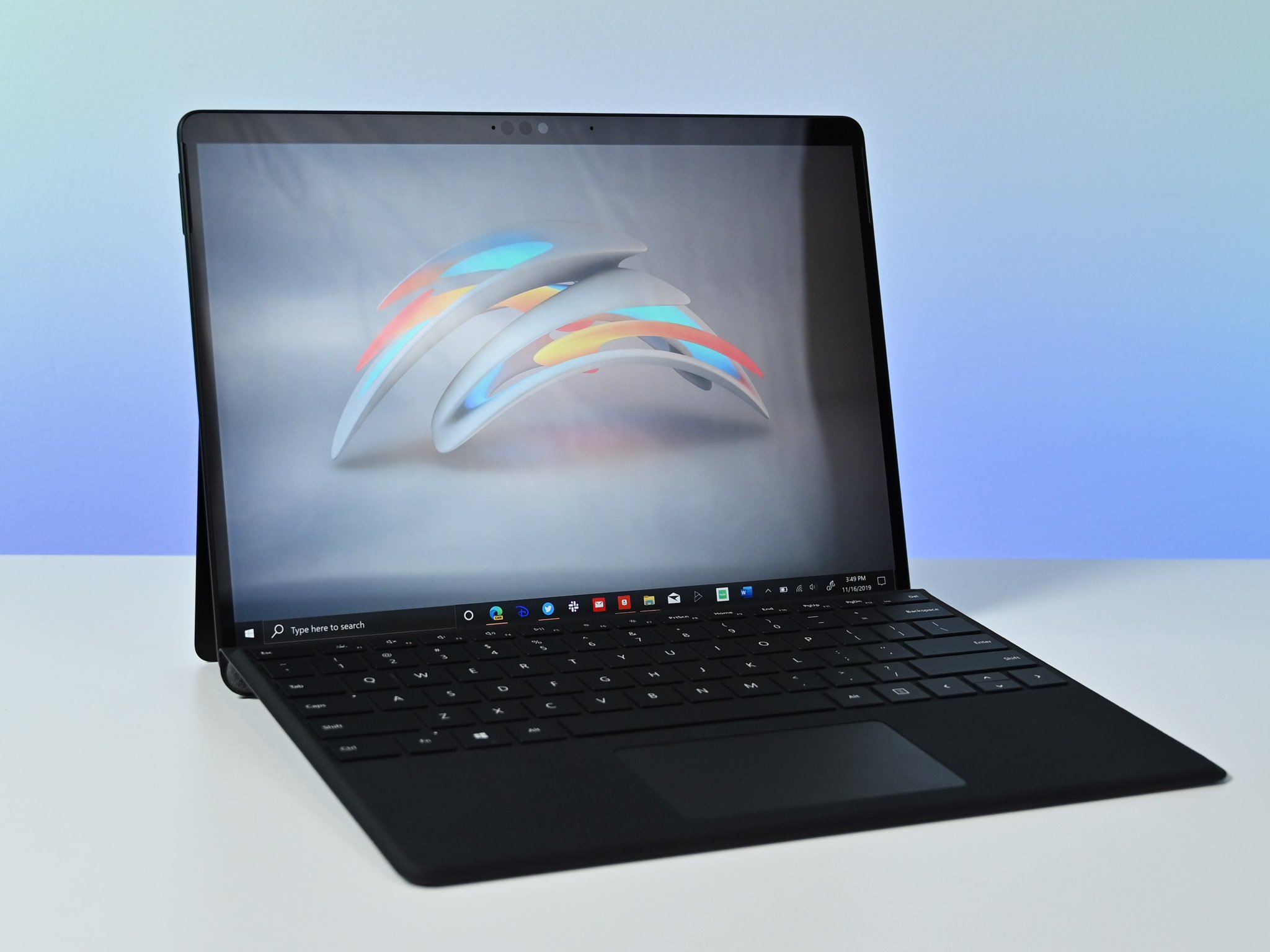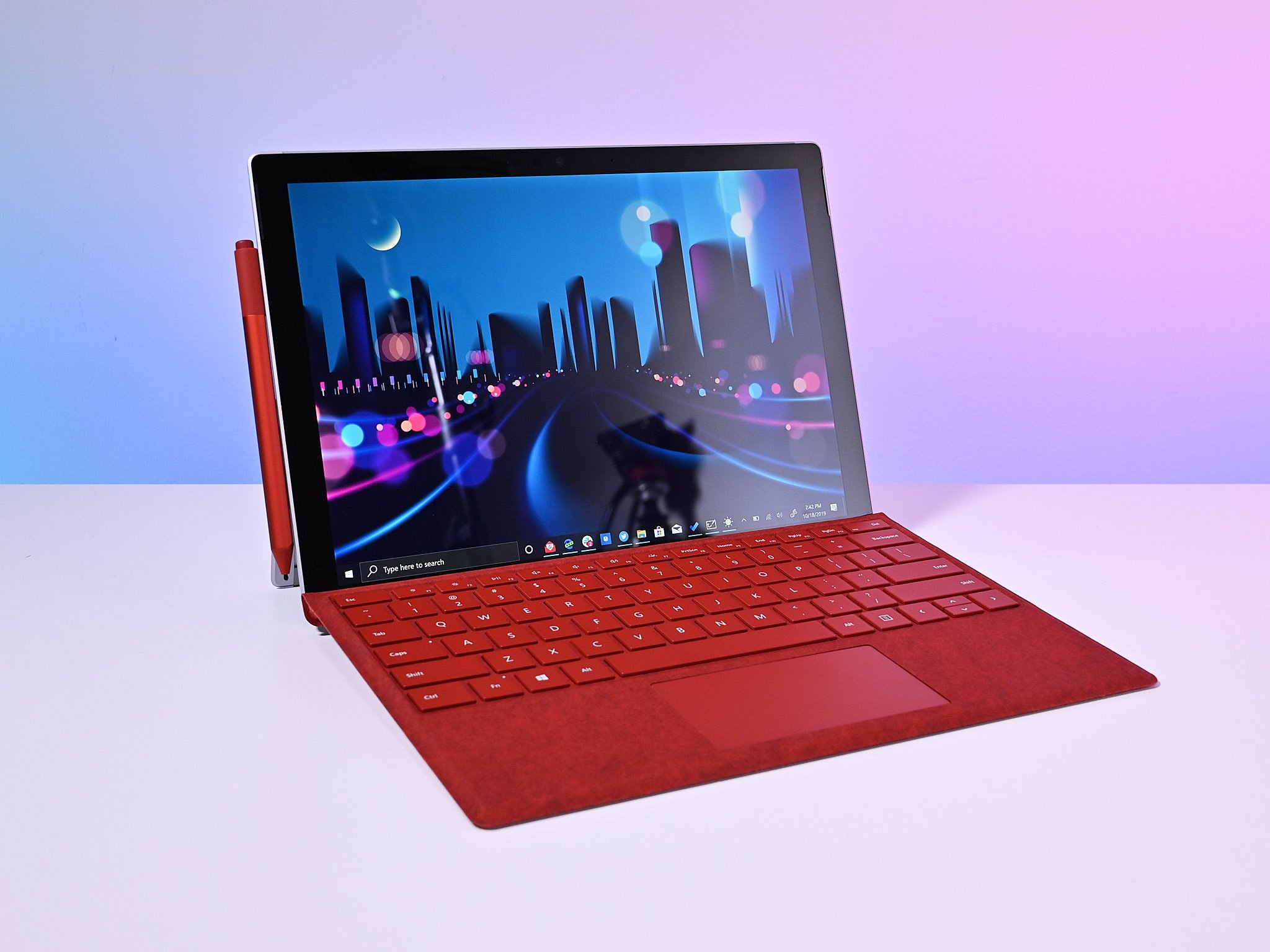Powerful Surface 2-in-1
Microsoft Surface Pro 7
Pros
- 10th Gen Intel Core CPUs available
- Works with Wi-Fi 6
- Cheaper starting price
- Up to 1TB storage
- Intel Iris Plus Graphics are relatively powerful
Cons
- Smaller display
- Less battery life
- No LTE connectivity
The Surface Pro 7 hasn't seen a huge physical change from the Pro 6, though it now has a USB-C port. Inside, 10th Gen Intel Core "Ice Lake" processor (CPU) options are available, which deliver improved performance and Wi-Fi 6 connectivity. The display isn't as big and battery life won't match up compared to the Pro X, but you can get a baseline Pro 7 for less money.
ARM-powered Pro
Microsoft Surface Pro X
Pros
- Adreno GPU with 2 teraflops
- LTE connectivity standard
- Two USB-C ports
- Thinnest and lightest Pro yet
- Smart design with new Surface Slim Pen
Cons
- No Wi-Fi 6 connectivity
- ARM has some limitations
- More expensive to start
- No 3.5mm audio jack
The Surface Pro X is Microsoft's thinnest Pro to date, but it does come at a higher starting price. It's powered by a custom Microsoft SQ1 or SQ2 CPU with Adreno 685 or 690 graphics (GPU) for ARM power and better battery life. You don't get Wi-Fi 6, but LTE connectivity means you can stay in touch anywhere. Add the Surface Slim Pen and Type Cover to the mix for an overall stellar device for creatives on the move.
The Surface Pro 7 is a continuation of the Pro design we've come to know and love, albeit with a few minor changes. On the other hand, the Surface Pro X is a significant departure, as it's the first ARM-powered Pro we've seen. It's built for a different usage scenario despite following similar design cues, and it was announced alongside a new Surface Slim Pen and Type Cover combination.
There's now the Surface Pro 7 Plus for Business, which adds optional 4G LTE, 11th Gen Intel Core CPU and Iris Xe integrated graphics, and longer battery life. Although I'll still be focusing on the standard Pro 7, you can check out our Surface Pro 7 Plus vs. Surface Pro 7 comparison to see all the major differences.
And there's also the SQ2 version of the Surface Pro X released late 2020. Aside from the upgraded ARM CPU, there's a new platinum color scheme, more colors for the Type Cover, and some general advancement in ARM and Windows. Both SQ1 and SQ2 models are still readily available to buy from Microsoft and other major retailers.
Let's take a look at the specs that make up these two devices.
Surface Pro 7 vs. Surface Pro X tech specs
| Surface Pro 7 | Surface Pro X | |
|---|---|---|
| OS | Windows 10 | Windows 10 |
| Processor | 10th Gen Intel Core i3-1005G1 Core i5-1035G4 Core i7-1065G7 |
Microsoft SQ1 Microsoft SQ2 |
| RAM | 4GB, 8GB, 16GB LPDDR4x | 8GB, 16GB LPDDR4x |
| Storage | 128GB, 256GB, 512GB, 1TB SSD | 128GB, 256GB, 512GB SSD |
| Display size | 12.3 inches Touch |
13 inches Touch |
| Display resolution | 2736x1824 267 PPI |
2880x1920 267 PPI |
| Aspect ratio | 3:2 | 3:2 |
| Graphics | Intel UHD (i3) Intel Iris Plus (i5, i7) |
Microsoft SQ1 Adreno 685 SQ2 Adreno 690 |
| Ports | USB-C 3.1 USB-A 3.5mm audio Surface Connect microSD card reader |
Two USB-C Surface Connect nano SIM |
| LTE | No | Qualcomm Snapdragon X24 LTE modem |
| Connectivity | Wi-Fi 6 Bluetooth 5.0 |
Wi-Fi 5 Bluetooth 5.0 |
| Camera | Front-facing 5MP (1080p) Rear-facing 8MP (1080p) |
Front-facing 5MP (1080p) Rear-facing 10MP (4K video) |
| Biometrics | IR camera | IR camera |
| Battery | Up to 10.5 hours | Up to 13 hours |
| Dimensions | 11.5 x 7.9 x 0.33 inches (292mm x 201mm x 8.5mm) |
11.3 x 8.2 x 0.28 inches (287mm x 208mm x 7.3mm) |
| Weight | From 1.7 pounds (775g) | From 1.7 pounds (774g) |
| Color | Platinum Matte Black |
Platinum Matte Black |
Design and features
If you're familiar with the previous generations of the 2-in-1 Pro lineup, not much has changed for the Pro 7. It still has the folding kickstand on the back, a unibody aluminum design, and it includes an IR camera for Windows Hello. It's so similar that you will be able to use older Type Covers and Surface Pens with the Pro 7, potentially saving you a good chunk of money if you're upgrading.
The Surface Pro X, on the other hand, has a thinner chassis that's lighter than Core i7 models of the Pro 7. It still has a kickstand on the back for propping up the tablet, and it works in tandem with a new style keyboard that has a storage bay for the new Surface Slim Pen you can buy separately.
For ports, the Pro 7 now includes USB-C instead of Mini DisplayPort, allowing more versatility while still offering external display support. The Pro X has two USB-C ports, but it doesn't have USB-A for your older devices. Both 2-in-1s have the proprietary Surface Connect port, and both have a Surface Keyboard connector. One thing that's irksome is a lack of 3.5mm audio jack on the Pro X; Microsoft has already put out a USB-C to 3.5mm adapter, so you'll have to jump on the dongle wagon if you'd like to use wired headphones.
There's no LTE connectivity for the Pro 7 (you'll have to go with the Pro 7 Plus for that), though it does offer Wi-Fi 6 connectivity for blazing wireless speeds. The Pro X is stuck on Wi-Fi 5, which is what we're used to, but it does have support for both physical (Nano SIM) and eSIM to keep you connected when out of Wi-Fi range.
The front-facing cameras are similarly 5 megapixel (1080p) on both models, though the rear-facing cameras differ. The Pro 7 has an 8-megapixel camera capable of 1080p video, while the Pro X has a 10-megapixel camera capable of 4K video. If you're concerned with capture quality, the Pro X will no doubt be the better choice.
Display and inking
Nothing has changed for the Surface Pro 7 in the touch display department compared to the Pro 6. It's sized at 12.3 inches with a 2736x1824 resolution and 267 PPI, with a boxy 3:2 aspect ratio that's ideal for a tablet. It works with the Surface Pen for a quality inking experience with 4,096 levels of pressure sensitivity and tilt support for shading. To keep the Pen nearby, it clips magnetically onto the side of the tablet.
The Pro X has shaken things up when it comes to the touch display. The chassis has almost the same footprint as the Pro 7's, but the screen has had its bezel shrunk to accommodate more screen real estate. The result is a 13-inch display with 2880x1920 resolution and 267 PPI. It has the same 3:2 aspect ratio and ultimately will offer about the same experience as you'll get with the Pro 7.
However, the Surface Slim Pen has a storage bay built into the attachable keyboard, where it will charge while not in use. If you're sick of your Pen falling off your Pro while in your bag, the Pro X's setup will be a welcome change. Note that the Slim Pen should work with other Surface devices.
Performance
The Surface Pro X is the first ARM-powered Pro device to hit the market. The original models have inside a custom 7nm Microsoft SQ1 7W CPU. It is essentially a suped-up Qualcomm Snapdragon 8cx complete with eight cores, 3GHz clock, and custom Adreno 685 graphics (GPU), able to power dual 4K external displays. There's also now the SQ2 version that gives a slight boost to performance. When I say slight, I mean slight. If you already have a Pro X with SQ1 CPU, the upgrade is certainly not worth it.
The GPU delivers 2 teraflops of power — the original Xbox One had 1.3 teraflops — but it's not exactly meant for gaming. OpenGL games won't work on ARM, and the device is ultimately suited best for web and scripted apps. UNITY and Unreal engines are getting ARM support, though, so we could begin to see some very good mobile games for the Pro X in the future. The Pro X isn't a gaming laptop, but it can certainly keep up with Intel's integrated graphics.
Intel Iris Plus Graphics in Core i5 and Core i7 Surface Pro 7 models will be able to handle light to medium gaming, but likewise don't expect it to perform as a gaming juggernaut. One thing to keep in mind is the arrival of Project xCloud, Microsoft's upcoming game-streaming service. With a fast, steady internet connection, both the Pro 7 and Pro X could be used for a quality gaming experience.
Geekbench 5
Geekbench 5.0 (CPU) (Higher is better)
| Device | CPU | Single-core | Multi-core |
|---|---|---|---|
| Surface Pro X | SQ2 | 798 | 3,100 |
| Surface Pro X | SQ1 | 725 | 2,819 |
| Surface Pro 7 | i5-1035G4 | 1,191 | 4,441 |
| Surface Pro 6 | i7-8650U | 1,113 | 3,519 |
| Surface Pro 6 | i5-8250U | 904 | 3,440 |
| Surface Laptop 3 | Ryzen 5 | 769 | 2,720 |
PCMark
PCMark 10
| Device | Score |
|---|---|
| Surface Pro X SQ2 | 5,088 |
| Surface Pro X SQ1 | 4,617 |
| Surface Pro 7 i5 | 3,992 |
| Surface Pro 6 i7 | 3,644 |
| Surface Pro 6 i5 | 3,501 |
| Surface Laptop 3 15 | 4,006 |
.
On the CPU side you will see some limitations in the ARM-powered Pro X, but in just about all cases you're going to be able to use your favorite software. And in terms of raw power, the SQ1 and SQ2 CPUs easily beat an 8th Gen Intel Core i5-8250U. They just won't beat out the 10th Gen chips in the Pro 7. Battery life hits eight hours regularly in the Pro 7, while the Pro X hits about 10 hours using ARM64 and UWP apps. It falls to about seven or eight hours if emulating 32-bit x86 apps.
RAM in both devices runs up to 16GB of LPDDR4x. You can go as low as 4GB of RAM in the Pro 7 to save money, while the Pro X drops down to 8GB. For storage, the Pro 7 goes up to a 1TB solid-state drive (SSD), while the Pro X maxes out at 512GB. However, storage on the Pro X can be removed without having to pull apart the entire chassis, something that's not possible on the Pro 7.
Price
Looking at Microsoft, prices for the Pro 7 start at $750. These baseline configurations include an Intel Core i3-1005G1 CPU, 4GB of RAM, and 128GB SSD, and do not include a Type Cover or Surface Pen. A decked-out model with Core i7-1065G7 CPU, 16GB of RAM, and 1TB SSD runs at about $2,100, making it considerably more expensive than the Pro X.
There are several variants of the Surface Pro X available to buy, including an introductory $850 model with SQ1 CPU, 8GB of RAM, and 128GB SSD. Bumping storage up to a 256GB SSD raises the price to about $1,000. Moving up to SQ2 models, you're looking at about $1,200 for a model with 16GB of RAM and a 256GB SSD. A high-end model with SQ2 CPU, 16GB of RAM, and 512GB SSD costs about $1,500.
Keep in mind that other retailers will likely have different prices, so you might be able to snag either device for even cheaper during a sale.
Go with the Surface Pro 7 for the best performance
The 10th Gen Intel Core "Ice Lake" CPUs available in the Pro 7 are going to be hard to beat in terms of raw performance, and Intel Iris Plus Graphics are no joke either. Add up to 1TB of storage space and enjoy Wi-Fi 6 wireless speeds. You won't get LTE here and battery life won't be quite as good, but the Pro 7 is a more traditional device that comes at a cheaper starting price. If neither of these devices are really to your liking, head over to our roundup of the best Windows laptop options.
Powerful Surface 2-in-1
Microsoft Surface Pro 7 2-in-1
10th Gen Intel CPUs and Wi-Fi 6
The Surface Pro 7 has been refreshed with 10th Gen Intel Core i3, i5, and i7 "Ice Lake" CPU options for improved performance, and it offers USB-C for added connectivity.
Stick with the Surface Pro X for ultimate portability
The ARM-powered Surface Pro X won't match up performance-wise with the higher-end Pro 7 models, but LTE connectivity, longer battery life, and a slimmer body make it easy to take with you wherever you go. A smart new storage system for a slimmer pen is an attractive addition, and two USB-C ports offer decent connectivity.
ARM-powered Pro
Microsoft Surface Pro X 2-in-1
Thinnest Surface Pro yet
Powered by a custom SQ1 or SQ2 CPU, powerful Adreno 685 or 690 GPU, and with LTE connectivity, the thinnest Surface Pro yet is able to keep up with a mobile lifestyle.








0 comments:
Post a Comment